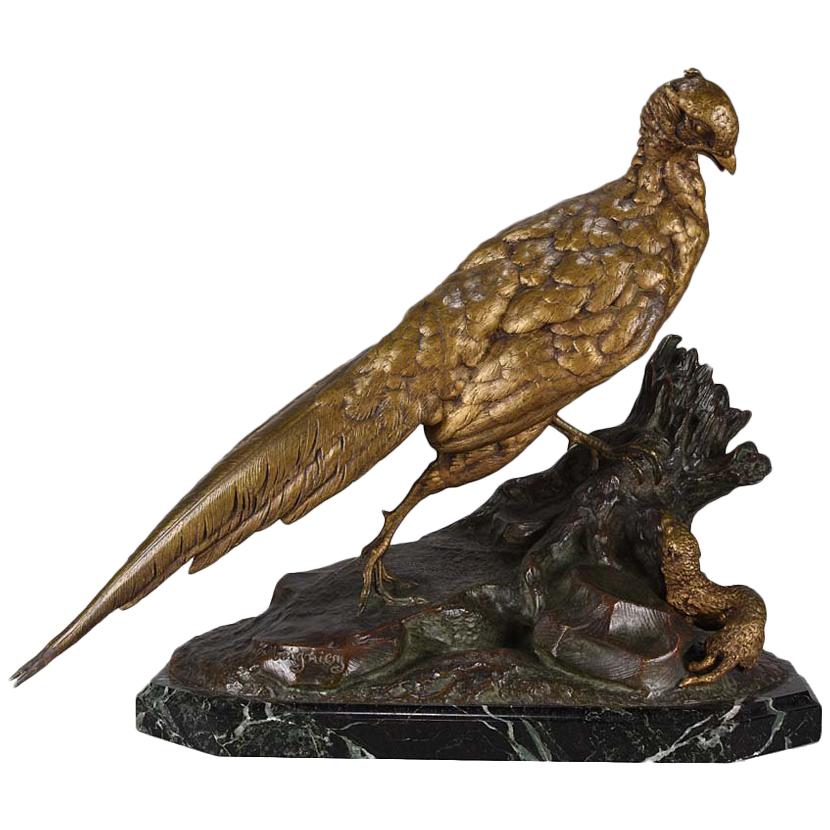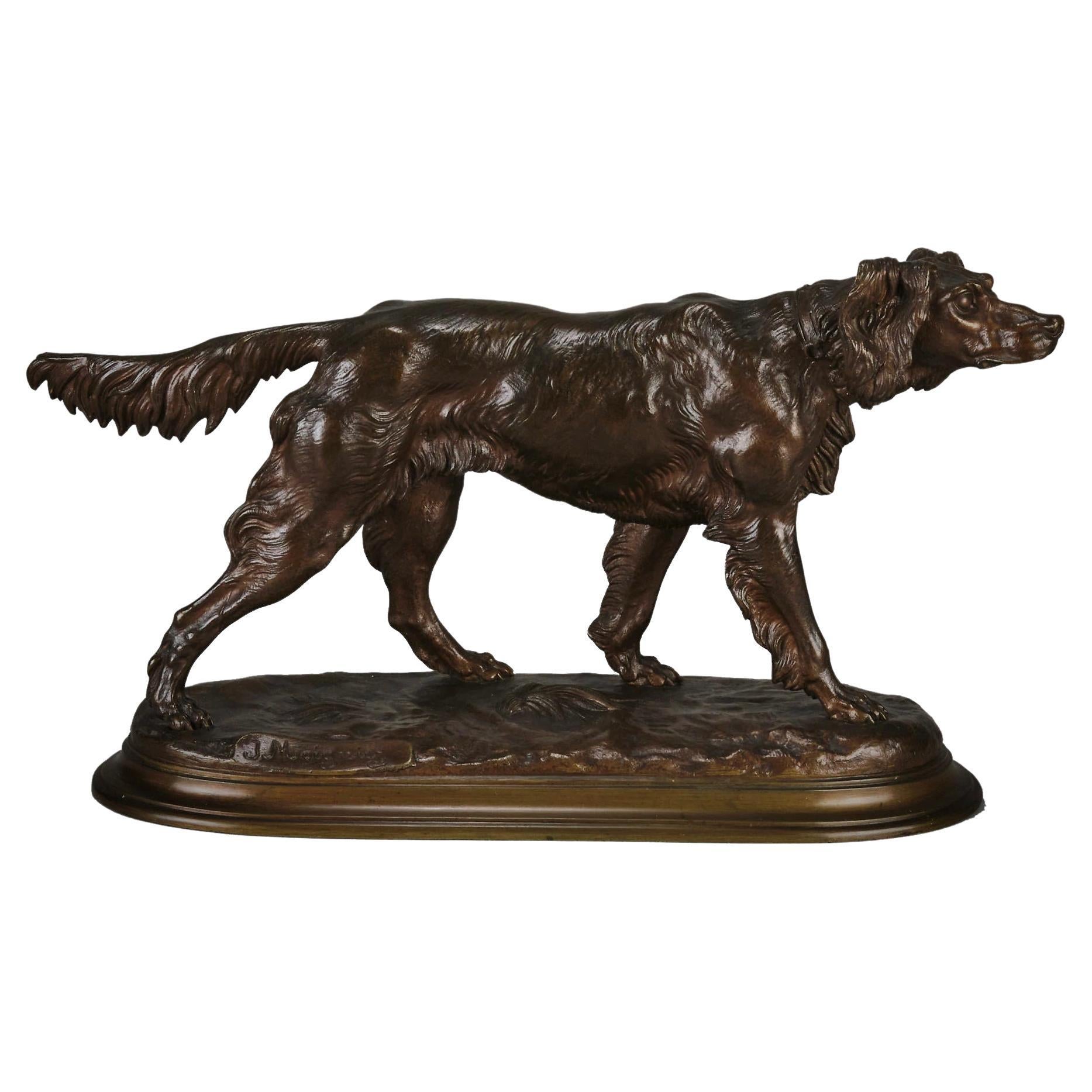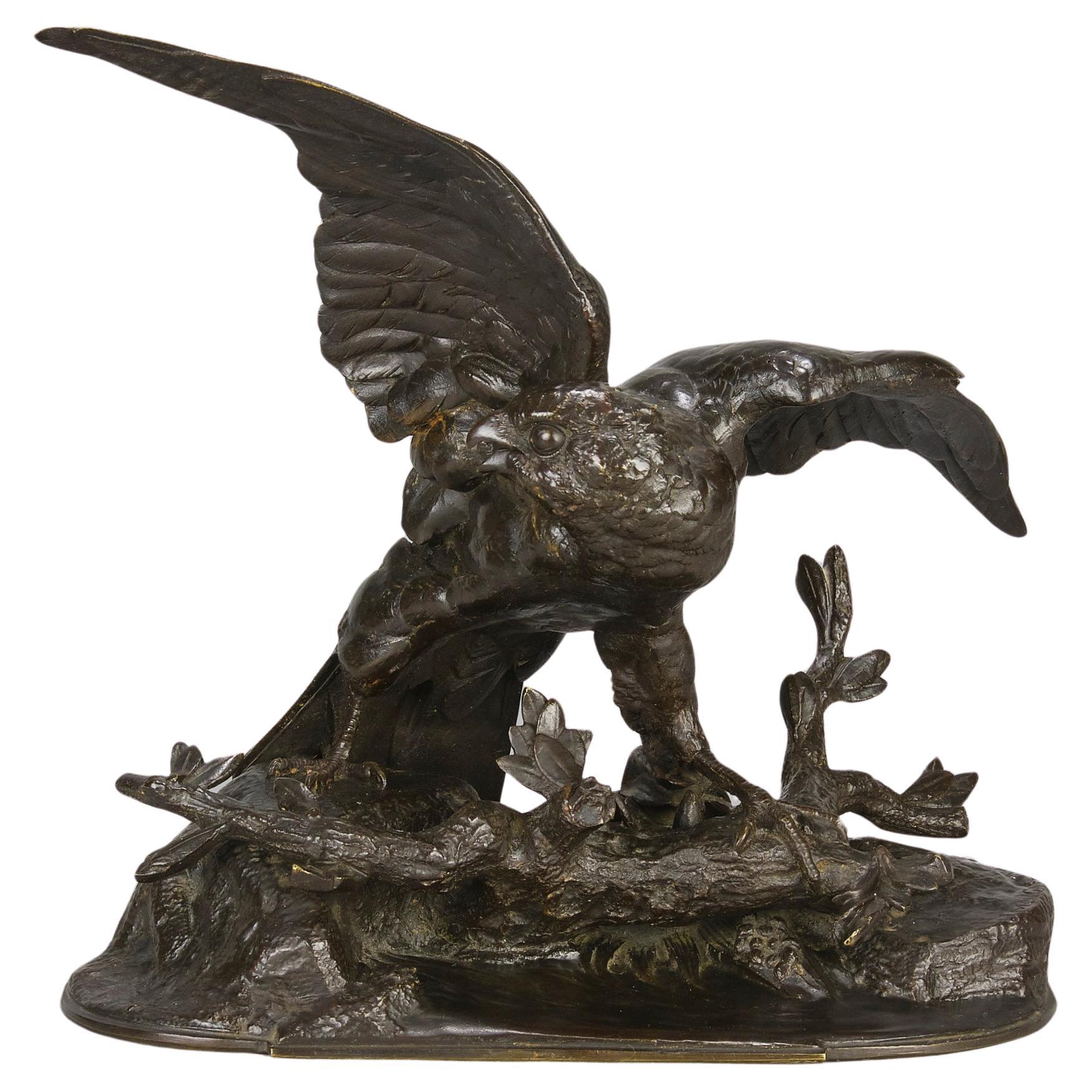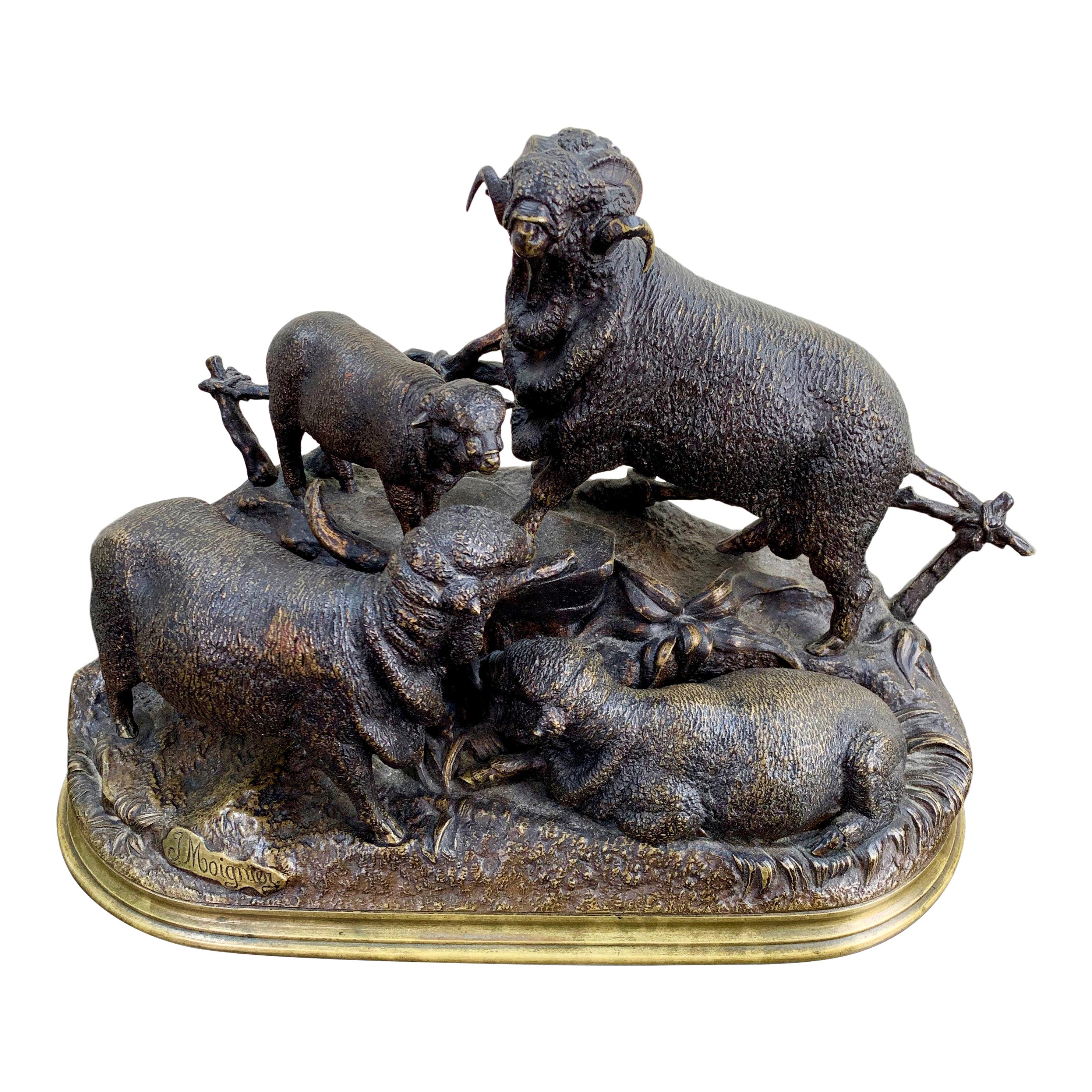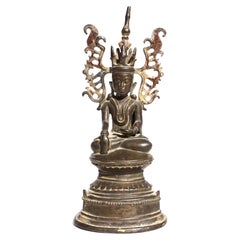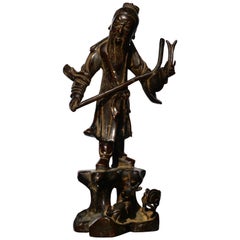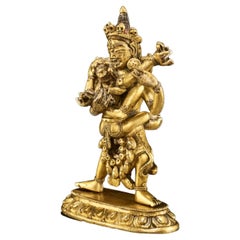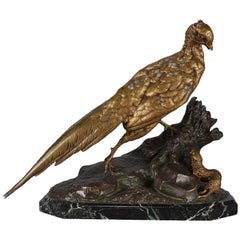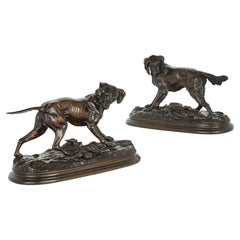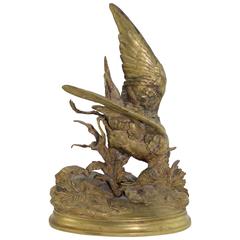
Jules Moigniez French Animalier Bronze, circa 1868, Sandpiper
View Similar Items
Want more images or videos?
Request additional images or videos from the seller
1 of 6
Jules Moigniez French Animalier Bronze, circa 1868, Sandpiper
About the Item
- Creator:Jules Moigniez (Artist)
- Dimensions:Height: 10.5 in (26.67 cm)Width: 7 in (17.78 cm)Depth: 5 in (12.7 cm)
- Style:Beaux Arts (Of the Period)
- Materials and Techniques:Bronze,Cast
- Place of Origin:
- Period:
- Date of Manufacture:1868
- Condition:Wear consistent with age and use. Minor losses. Condition: Very good with ware indicative of age. Loss to gilding with oxidation. Tiny hole on left side of statue base original to casting. Bird NOT tightly attached. Beak slightly bent.
- Seller Location:Dallas, TX
- Reference Number:1stDibs: LU177423812702
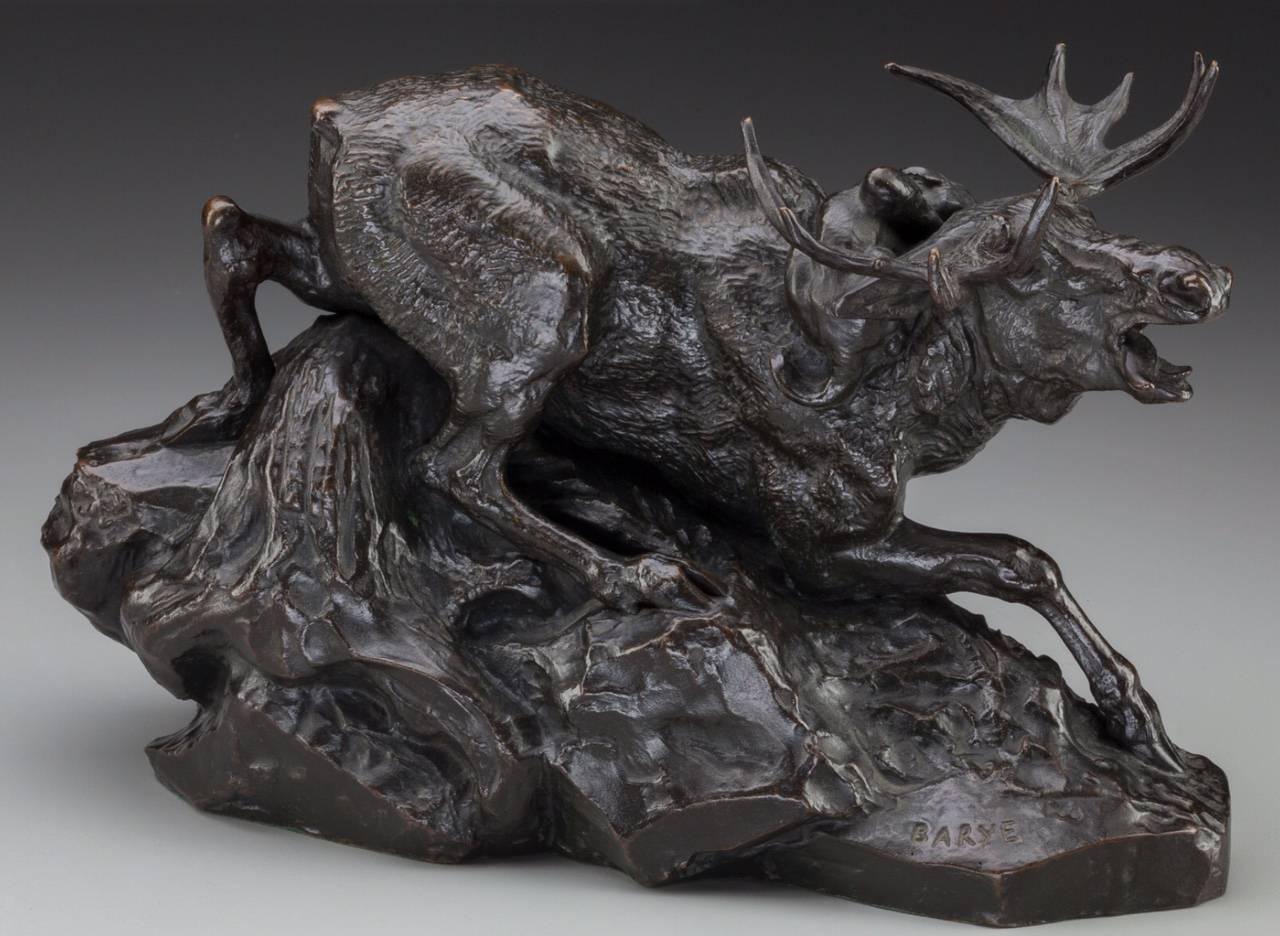
About the Seller
4.9
Gold Seller
These expertly vetted sellers are highly rated and consistently exceed customer expectations.
Established in 2000
1stDibs seller since 2015
402 sales on 1stDibs
Typical response time: 1 hour
More From This SellerView All
- Thai Southeast Asian Bronze Seated Buddha, Circa 17th CenturyLocated in Dallas, TXPossibly Khmir period but probably just after. Bronze buddha seated in bhumisparsha mudra on stepped base, remnants of earlier gilding throughout, I have been dealing in ancient bronze Buddhas...Category
Antique 17th Century Ming Figurative Sculptures
MaterialsBronze
- Ming Dynasty Bronze Luohan with DeerLocated in Dallas, TXA very whimsical and spirited Luohan from calls in the beasts of the forest as to protect them from harm. These bronzes are rare but come up for sale from time to time. This piece sh...Category
Antique 16th Century Chinese Ming Figurative Sculptures
MaterialsBronze
- Gilt Bronze Figure of Chakrasamvara and VajravahariLocated in Dallas, TXA gilt bronze figure of Chakrasamvara and Vajravahari, 17th-18th century Tibet, 18th century. The two in embrace striding in alidhasana atop a lotus base with a beaded edge. He is holding vajra and ghanta and is adorned with a long garland of severed heads and skulls, the face with a third eye below a skull tiara, the hair pulled into a high chignon. She is holding a flaying knife and skull cup...Category
Antique Late 17th Century Tibetan Tibetan Figurative Sculptures
MaterialsBronze
- Charles Korschann Art Nouveau Gilt Bronze NudeBy Charles KorschannLocated in Dallas, TXCharles Korschann Czechoslovakian Art Nouveau Gilt-Bronze Figural Bud Vase. Cast from a model by Charles (Karl) Korschann, circa 1899, of urn form, with a handle in the form of a...Category
Antique 1890s Czech Art Nouveau Figurative Sculptures
MaterialsBronze
- Japanese Meiji Genryusai Seiya Bronze Elephant and TigersLocated in Dallas, TXJapanese Meiji Genryusai Seiya bronze elephant and tigers, circa 1890. This moving and detailed bronze grouping depicts a savage attack by two viscous...Category
Antique 1890s Japanese Meiji Animal Sculptures
MaterialsBronze
- Charles Raphaël Peyre Art Nouveau Gilt Bronze MaidenBy Charles Raphaël PeyreLocated in Dallas, TXCharles Raphaël Peyre (French 1874-1949) A French Art Nouveau Gilt-Bronze Figure of a Maiden Cast by Louchet, circa 1900 Modeled in a standing pose with her hands clasped closed...Category
Antique Early 1900s French Art Nouveau Figurative Sculptures
MaterialsBronze
You May Also Like
- Animalier French Bronze 'Pheasant & Weasel' by Jules MoigniezBy Jules MoigniezLocated in London, GBA large and impressive late 19th century French animalier bronze group of a Pheasant surprised by a weasel, both animals heightened with original gilding and raised on a naturalistic...Category
Antique 1870s French Other Animal Sculptures
MaterialsBronze
- Pair of Animalier Bronze Dog Sculptures by Jules MoigniezBy Jules MoigniezLocated in London, GBPair of animalier bronze dog sculptures by Jules Moigniez French, late 19th Century Measures:Height 13cm, width 22cm, depth 10cm This charming pair of dog sculptures is by the F...Category
Antique Late 19th Century French Animal Sculptures
MaterialsBronze
- Jules Moigniez, French Bronze HorseBy Jules MoigniezLocated in Norwalk, CTAn untitled bronze sculpture depicting a horse and greyhound. Beautiful bronze work, standing on realistic base, signed on the back of the base: J. Moigniez (French 1835-1894). This ...Category
Antique 19th Century French Animal Sculptures
MaterialsBronze
- “Standing Setter” French Animaliers Bronze by Jules Moigniez, circa 1870Located in London, GBVery fine mid-19th century French Animalier bronze study of a standing Setter with excellent hand chased surface detail and rich brown patination. Raised on a stepped naturalistic base, signed J Moigniez. Additional information: Height: 19 cm Width: 34 cm Condition: excellent original condition Circa: 1870 Materials: bronze Book reference: Les Animaliers by Jane Horswell Page no. 237 About Jules Moigniez (French, 1835 ~ 1894) Moigniez was a French animalier sculptor of the 19th century. He worked primarily in bronze and frequently exhibited his sculptures at the Paris salon. He was best known for his bronzes depicting birds, although his skill and versatility enabled him to produce quality horse sculptures (primarily racehorses), dog sculptures and hunting scenes. His bird sculptures were among the finest ever created in his time. Moigniez was born at Senlis, Oise, France in 1835, the son of a metal gilder. Moigniez’s father bought a foundry to cast his sculptures, which was of great benefit to Moigniez as he didn’t have the added foundry costs that most of his contemporaries had to pay. Moigniez studied sculpture under the tutelage of Paul Comoléra (a student of François Rude) in Paris. It is quite likely that Moigniez’s attraction to bird sculpture was a direct result of his education under Comoléra, who was himself a bird specialist. Over the course of his 40-year sculpting career Moigniez exhibited thirty works at the Salon between 1855–92. His first submission in a major art exhibition was his plaster, Pointer Stopping at a Pheasant, at the Exposition Universelle of 1855.[1][2] Moigniez was known for the fine detail and chiseling of his sculptures. His bronzes—usually cast using the lost wax method—were always immaculately chased and patinated, and were especially popular in England and Scotland.[2] More than half of his output during his lifetime was sold in the United Kingdom. By the end of the 19th century, his sculpture had become popular in the United States as well. In contrast with other animaliers of the period such are P.J. Mêne and Antoine-Louis Barye, Moigniez’s bird sculptures often incorporated highly detailed bases complete with bushes, extensive foliage and undergrowth. His castings were generally of excellent quality with a variety of patinas, the gilded and silvered patinas being the most desirable and sought after by collectors. His bronzes could be reproached for an excess of detail, a result of overly-finicky, over-worked chiseling. Moigniez received redemption, however, by portraying in his sculpture a certain “elegance of attitudes”. His Chien braque...Category
Antique 19th Century Animal Sculptures
MaterialsBronze
- 19th Century Animalier Bronze Sculpture entitled "Falcon" by Jules MoigniezBy Jules MoigniezLocated in London, GBAn excellent mid 19th Century French Animalier bronze study of a falcon perched on a branch using its outspread wings to balance and with its beak open. The bronze exhibiting excellent intricate hand chased surface detail and very fine rich brown lightly rubbed patination, signed J Moigniez. ADDITIONAL INFORMATION Height: 23 cm Width: 23 cm Condition: Excellent Original Condition Circa: 1870 Materials: Bronze Book reference: Animals in Bronze by Christopher Paine Page no. 79 SKU: 9000 ABOUT Jules Moigniez (French, 1835 ~ 1894) Moigniez was a French animalier sculptor of the 19th century. He worked primarily in bronze and frequently exhibited his sculptures at the Paris salon. He was best known for his bronzes depicting birds, although his skill and versatility enabled him to produce quality horse sculptures (primarily racehorses), dog sculptures and hunting scenes. His bird sculptures were among the finest ever created in his time. Moigniez was born at Senlis, Oise, France in 1835, the son of a metal gilder. Moigniez’s father bought a foundry to cast his sculptures, which was of great benefit to Moigniez as he didn’t have the added foundry costs that most of his contemporaries had to pay. Moigniez studied sculpture under the tutelage of Paul Comoléra (a student of François Rude) in Paris. It is quite likely that Moigniez’s attraction to bird sculpture was a direct result of his education under Comoléra, who was himself a bird specialist. Over the course of his 40-year sculpting career Moigniez exhibited thirty works at the Salon between 1855–92. His first submission in a major art exhibition was his plaster, Pointer Stopping at a Pheasant, at the Exposition Universelle of 1855.[1][2] Moigniez was known for the fine detail and chiseling of his sculptures. His bronzes—usually cast using the lost wax method—were always immaculately chased and patinated, and were especially popular in England and Scotland.[2] More than half of his output during his lifetime was sold in the United Kingdom. By the end of the 19th century, his sculpture had become popular in the United States as well. In contrast with other animaliers of the period such are P.J. Mêne and Antoine-Louis Barye, Moigniez’s bird sculptures often incorporated highly detailed bases complete with bushes, extensive foliage and undergrowth. His castings were generally of excellent quality with a variety of patinas, the gilded and silvered patinas being the most desirable and sought after by collectors. His bronzes could be reproached for an excess of detail, a result of overly-finicky, over-worked chiseling. Moigniez received redemption, however, by portraying in his sculpture a certain “elegance of attitudes”. His Chien braque...Category
Antique Mid-19th Century French Art Nouveau Animal Sculptures
MaterialsBronze
- Patriotic Eagle Bronze Sculpture After Jules MoigniezBy Jules MoigniezLocated in Colorado Springs, COPresented is a 20th century bronze sculpture, after Jules Moigniez, of an eagle on a rocky perch. The dignified eagle has its wings tucked and his head turned to the side, showcasing exquisite craftsmanship. Textured feathers, a rugged base, and sharp talons show Moigniez’s artistry at the lost wax process. The bronze sculpture sits atop a marble base. Jules Moigniez (1835-1894) was a French sculptor widely known for his highly detailed bronze works depicting dynamic wildlife. After studying under Paul Cromolera, Moigniez made a name for himself at his first exhibition in 1855 at the Paris Exposition Universelle. From 1859 to 1892, he showed regularly at the annual Saloons, with a total of 30 recorded works exhibited. A successful sculptor in France, Moignez increased his British and American collector base by exhibiting at the London International Exhibition of 1862. Intensely dedicated to the process of casting, Jules and his father decided to establish their own foundry in 1857, solely for the purpose of having complete control at every step, as well as the freedom to experiment. They created bronzes with unusually and unique finishes, experimenting in gilded, silver, and multi-color chemical patinas. Most of his works were cast using the lost-wax patina and were always chiseled and chased with great skill and care. While many bronze artists at the time focused solely on the subject, Moigniez incorporated highly detailed bases to accommodate his various animals. After Jules Moigniez’s tragic death in 1894, his father continued to cast his son’s bronzes from the Moigniez foundry. Just before Moigniez’s father also passed away, he sold the foundry and his casts to Auguste Gouge, a family friend who once cast bronzes for Jules' teacher Paul Cromolera. Gouge continued to produce Moigniez’s bronze sculptures until WWI. Eagle sculptures, such as this, gained such popularity in America because of the symbolic and historical meanings associated with the elegant bird. The eagle motif has been widely used throughout American history, most notably as part of our Great Seal. The founders of the United States were fond of comparing their new republic with the Roman Republic, in which eagle imagery was prominent. Since then, the eagle motif has appeared in allegorical engravings...Category
20th Century Sculptures and Carvings
MaterialsBronze
